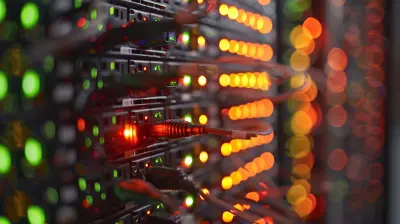How to Use Data Analytics for Fraud Detection
26 May 2025
In today's digital world, data is everywhere. We live in an era where there's so much data floating around that it's almost impossible to keep track of it all. Businesses, governments, and organizations have access to massive amounts of data—more than ever before. But here's the thing: with all that data, there's also a bigger chance of fraud. And that’s where data analytics comes in.
Have you ever wondered how companies can detect fraudulent activities in real-time? Or how online platforms catch shady transactions before they cause chaos? Well, the answer lies in the magical world of data analytics. In this article, we'll dive deep into how data analytics can help with fraud detection. And don't worry, we’ll keep things simple and engaging, so even if you’re not a tech geek, you’ll still walk away with a solid understanding.

Why Fraud Detection is More Important Than Ever
Before we jump into the nitty-gritty of how data analytics helps in fraud detection, let’s talk a bit about why fraud detection is such a big deal.Fraud is not just something that happens in movies or crime shows. It happens in real life, and it's more common than you'd think. Whether it’s a hacker stealing credit card information or someone making false insurance claims, fraud can have devastating effects on businesses and individuals alike.
In fact, fraud costs businesses billions of dollars every year. According to the Association of Certified Fraud Examiners (ACFE), businesses lose around 5% of their revenue annually to fraud. That’s a staggering number! And if you’re running a business, that could mean the difference between thriving and going under.
So, what can be done? Well, that’s where technology steps in to save the day. Specifically, data analytics can help detect fraud before it spirals out of control.

What is Data Analytics?
Alright, let’s start with the basics. You’ve probably heard the term “data analytics” thrown around a lot. But what exactly is it?Data analytics is the process of examining large datasets to uncover hidden patterns, correlations, and trends. It’s basically like being a detective, but for numbers and data. You sift through tons of information to find useful insights.
Now, there are several types of data analytics:
- Descriptive Analytics: This tells you what happened in the past.
- Predictive Analytics: This predicts what could happen in the future based on past data.
- Prescriptive Analytics: This suggests actions that could be taken based on predictions.
For fraud detection, predictive and prescriptive analytics are the real game-changers. They help companies not only identify potential fraud but also take steps to prevent it from happening in the first place.

How Data Analytics Works for Fraud Detection
So, how does the magic happen? How can data analytics actually help detect fraud? Let’s break it down.1. Identifying Anomalies
One of the primary ways data analytics helps in fraud detection is by identifying anomalies. Think of anomalies as the weird stuff that doesn’t fit the pattern. For example, if someone tries to make a $10,000 purchase using your credit card while you’re living paycheck to paycheck, that’s an anomaly.Data analytics tools can sift through massive amounts of data and flag any transactions or activities that seem suspicious. These anomalies are often the first sign that something fishy is going on.
But here’s the twist: not every anomaly is fraud. Sometimes, anomalies are just outliers—like when you splurge on a vacation after saving up for a year. That’s why it’s important to have a system in place that can distinguish between innocent anomalies and actual fraud.
2. Pattern Recognition
Humans are creatures of habit. When we do something, we generally follow a pattern. Whether it’s how we spend money, how we log into our accounts, or how we interact online, there’s usually a recognizable pattern.Fraudsters, however, tend to break these patterns. They may try to access your account from unusual locations, make purchases at odd hours, or transfer large sums of money all at once. This is where pattern recognition comes into play.
Data analytics tools are great at recognizing patterns. They can analyze past behavior and establish a “normal” pattern for each individual or transaction. When something deviates from that pattern, it raises a red flag.
For example, if you usually log into your account from New York, but suddenly someone tries accessing it from Russia, that’s a break in the pattern. Data analytics can detect such irregularities and alert the system to take action—like freezing the account or sending you a warning.
3. Machine Learning Algorithms
Here’s where things get a little fancy: machine learning. Machine learning is a subset of artificial intelligence (AI) that allows computers to learn from data without being explicitly programmed. In the context of fraud detection, machine learning algorithms can be trained to recognize fraudulent behavior based on historical data.These algorithms can process huge amounts of data and learn from the patterns they observe. Over time, they become better at predicting and detecting fraud. The more data you feed them, the smarter they get.
One of the coolest things about machine learning is that it can adapt. Fraudsters are constantly coming up with new schemes, but machine learning algorithms can evolve and adjust to new types of fraud. It’s like having a fraud-detecting superpower that keeps getting stronger over time.
4. Real-Time Monitoring
In the world of fraud detection, timing is everything. The faster you can catch fraud, the better. That’s where real-time monitoring comes in.With data analytics, companies can monitor transactions and activities in real-time. This means they can catch suspicious behavior as it happens, rather than waiting for damage control after the fact.
For example, if someone tries to make an unauthorized withdrawal from your bank account, real-time monitoring can detect the odd transaction and block it before the money is gone. This kind of instant response is crucial when it comes to minimizing losses.
5. Risk Scoring
Not all transactions are created equal. Some are riskier than others. For instance, a transaction made from a high-fraud location or a new, unverified account is more likely to be fraudulent than a routine purchase from a familiar merchant.That’s where risk scoring comes in. Data analytics systems assign a risk score to each transaction based on various factors like location, transaction history, and user behavior. The higher the risk score, the more likely it is that the transaction is fraudulent.
Based on this score, the system can either approve or reject the transaction, or flag it for further investigation. This allows businesses to focus their resources on high-risk transactions without slowing down the process for legitimate users.

Industries Using Data Analytics for Fraud Detection
Now that we’ve covered how data analytics works for fraud detection, let’s take a look at some of the industries that are using this technology to protect themselves.1. Banking and Financial Services
The banking industry is one of the biggest targets for fraud. With millions of transactions happening every day, it’s no surprise that fraudsters are constantly trying to exploit the system.Banks and financial institutions use data analytics to monitor transactions, detect anomalies, and identify suspicious behavior. They also use machine learning algorithms to predict potential fraud before it happens.
2. E-Commerce
Online shopping is super convenient, but it also comes with its own set of risks, like credit card fraud and account takeovers. E-commerce platforms use data analytics to track user behavior, monitor transactions, and flag any unusual activity.For example, if someone tries to log into your account from a device or location that’s never been used before, the system will recognize the anomaly and take action, like sending you a verification code or freezing the account temporarily.
3. Insurance
Insurance fraud is another major issue. Whether it’s false claims or inflated damage reports, fraudsters are always looking for ways to game the system. Insurance companies use data analytics to detect patterns and anomalies in claims, helping them identify fraudulent activity before paying out.4. Telecommunications
In the telecom industry, fraud can take many forms, from fake subscriptions to unauthorized charges. Data analytics helps telecom companies monitor usage patterns and detect any irregularities that could indicate fraud.Challenges in Using Data Analytics for Fraud Detection
While data analytics is a powerful tool for fraud detection, it’s not without its challenges.1. False Positives
One of the biggest challenges is dealing with false positives. These occur when the system flags legitimate transactions as fraudulent. While it’s better to be safe than sorry, too many false positives can frustrate customers and slow down business operations.2. Data Privacy
With so much data being collected and analyzed, there’s always the risk of violating privacy regulations. Companies need to ensure that they’re complying with laws like GDPR and protecting their customers’ sensitive information.3. Constantly Evolving Fraud Tactics
Fraudsters aren’t standing still. They’re constantly coming up with new ways to exploit systems, which means data analytics tools need to keep evolving as well. This requires continuous updates and improvements to stay one step ahead of the fraudsters.
The Future of Fraud Detection with Data Analytics
As technology continues to advance, the future of fraud detection looks promising. Artificial intelligence, blockchain, and big data are all expected to play a major role in shaping the future of fraud detection.With more sophisticated machine learning algorithms and real-time monitoring, we can expect fraud detection systems to become even more accurate and efficient. And as more industries adopt data analytics for fraud detection, fraudsters will have a harder time getting away with their schemes.
Conclusion
Fraud is an ever-present threat in today’s digital world, but data analytics provides a powerful defense. By identifying anomalies, recognizing patterns, and using machine learning algorithms, companies can detect fraud before it causes serious damage. Whether you're in banking, e-commerce, insurance, or telecommunications, data analytics is a must-have tool in your fraud detection arsenal.So, the next time you’re wondering how companies manage to catch fraudsters so quickly, remember: it’s all thanks to the magic of data analytics.
all images in this post were generated using AI tools
Category:
Data AnalyticsAuthor:

Gabriel Sullivan
Discussion
rate this article
3 comments
Morgan McCord
Great insights! Data analytics is crucial for effective fraud detection and prevention.
June 15, 2025 at 3:30 AM

Gabriel Sullivan
Thank you! I'm glad you found the insights valuable. Data analytics truly plays a pivotal role in enhancing fraud detection and prevention strategies.
Selkie O'Neal
This article offers invaluable insights into leveraging data analytics for fraud detection. It’s inspiring to see technology used for such a crucial purpose. Empowering organizations to protect themselves and their customers is truly commendable. Thank you for sharing this knowledge!
May 30, 2025 at 12:57 PM

Gabriel Sullivan
Thank you for your kind words! I'm glad you found the article helpful in understanding the importance of data analytics in fraud detection.
Archer Graham
Data analytics is a game-changer in fraud detection. Leveraging advanced algorithms and real-time data can significantly enhance security measures. Organizations must prioritize adopting these technologies to outsmart fraudsters and protect their assets effectively. The time to innovate is now!
May 26, 2025 at 4:14 AM

Gabriel Sullivan
Thank you for your insights! I completely agree—leveraging data analytics is crucial for staying ahead of fraudsters and enhancing security. Innovation in this area is indeed vital for effective asset protection.


